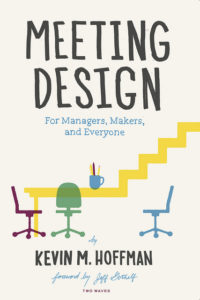Editors’ note: This “Book in Brief” feature here on Boxes and Arrows is from Kevin Hoffman’s Meeting Design for Managers, Makers, and Everyone.
We’ll publish an excerpt, up to 500 words, of your book. The catch is that we’ll only publicize one book a month; first come, first serve. Other rules will certainly occur to us over time. Hit us up at idea at boxesandarrows.com.
How to Design a Meeting
When hundreds of hours of his design team’s sweat, blood, and tears seemed to go up in flames in a single meeting with a group of vice presidents, Jim could have easily panicked. So that’s what he did.

Jim is a creative director at a successful and highly respected boutique design agency—let’s call it “Rocket Design.” He found a fantastic opportunity for Rocket through a former coworker’s new job at a Fortune 100 client—they were ready to spend half a million dollars to build the best website experience possible in a competitive market: online meal delivery. After several weeks of discovery, his team had assembled a design direction that they believed could be effective. Baked into a collection of mocked-up mobile screens were strategies guiding content voice, brand execution, photographic style, and user interface functionality. To move into the next phase, Jim’s job was to make sure that the senior leadership at the company believed in the proposed direction just as strongly as his team did. Project managers on the client side navigated the rat’s nest of the leadership’s meeting availability to find a standing monthly hour in which Jim and his team could provide progress updates.
At one of these check-in meetings, Jim walked the gathered group of vice presidents and directors through a series of screens, stopping to accent unique elements and key decisions along the way. Despite asking people to hold questions until the end, there were a handful of odd interruptions, like this gem:
“That’s a really strong yellow. I just don’t know about that.”
Jim found the interruptions unnerving, each one forcing him to reset his presentation rhythm and remind the group to wait until he was finished. When he reached the end of his walkthrough, a bit rattled, he opened the floor for an unstructured session of comments and questions. The comments and questions came fast, furious, and, of course, unstructured, like invaders from all sides breaching a fortified position:
“What will you do differently to accommodate our unique business rules around delivery partners?”
“This must work within our existing JavaScript framework, so that will happen, right?”
“Were you aware that we’ve got an internal team working on this exact same issue, and they’ve already wireframed the whole thing?”
Jim struggled through, answering each off-topic comment and occasionally handing questions off to the most qualified individuals on his team. But his frustration wasn’t masked in the slightest: Jim interrupted people mid-comment, stammered when surprised, and answered brusquely with “that’s out of scope!” in response to the last few questions.
In conceiving the agenda for this presentation, Jim made an error that nearly cost his team the project. He didn’t design the conversation to help key stakeholders understand what had gone into all of these decisions. Instead, he did what he had learned to do by example from his boss, the previous creative director, which is often how agencies teach people to present work. Jim provided a “real estate tour” of the finished product, assuming the rationale behind the designs was obvious. But to client leadership that hadn’t been along for the ride, the destination was startling and unclear.
What is a well-designed meeting?
Well-designed things make our lives simpler or more pleasing. Design is an intangible currency that separates things that matter from junk. Something designed has been given appropriate and actionable consideration, with forethought and research guiding its creation and ongoing evolution.
Meetings are usually not designed. They are rather used as blunt force, expensive but ill-considered tools to solve communications problems. These problems don’t always warrant such a costly, high-fidelity solution. But even when they do merit that kind of solution, insufficient intention and energy go into creating the meeting experience itself.
If you are feeling like there’s no agenda and not sure why everyone is there, you’re likely not the only one.
CARRIE HANE
DIGITAL COMMUNICATIONS STRATEGY COACH, TANZEN
A lack of a clearly defined agenda is a symptom of the problem, but designing a meeting means more than just having an agenda. The problem is that meetings aren’t considered in the same way that designers consider problems they are trying to solve. That’s what “designing a meeting” is all about: thinking about your meetings as though you were a designer.
